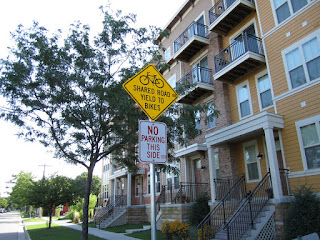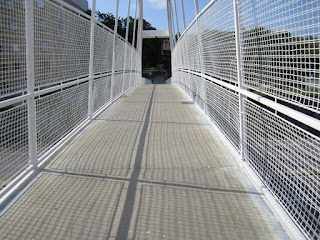This weekend, the City of Madison and Trek Bicycles, among others, put on an event called Ride the Drive. A six mile loop through Madison was blocked off for cyclists to ride a loop with Lance, and to enjoy car-free streets for a day. For me, the event started earlier in the week when I volunteered to put up "Modified Route" signs along part of the route. Turns out carrying 30 of these signs with just a messenger bag is quite a challenge, in terms of both size and weight.
I rode the signs home about 3 miles on my messenger bag and decided I could use the Brompton bag frame and some bungee cords to transport the signs. Here's what that ended up looking like:

On the day of the event, I rode up to Capitol Square and picked up my volunteer T-shirt. I worked my way through the masses to stage right where Lance would speak briefly.


(I'm a little creeped out by Lance checking me out. John Burke and Mayor Dave on the stand.)
Mayor Dave discussing the city goal of making 20% of trips by bicycle:
John Burke's introduction:
Lance's thoughts:
I believe I was the only one wearing a tie at the event (see below). Trek Bicycle President John Burke spoke and introduced Lance Armstrong to the hungry crowd. Lance got the crowd pumped and we were on our way.
By the time I made it 1.5 blocks around the Capitol to the top of State Street, it looked something like this:

(Click for full-size effect)
Here's a shot at John Nolen Drive:

And one of East Washington Ave.:

I ran into some of my new classmates, Hanjin and Jia as I was heading home. They weren't there for the bikes, but I'll count it!
What I was a part of today was more than simply riding a bike on a car-free street or two. Zooming out on the event as a whole, I saw an incredible partnership comprised of concerned citizens, responsible and proactive civic leadership, corporations, and celebrity working together toward a common goal. With such a variety of interested parties working in concert toward a goal, such as 20 by 2020, reaching that goal is credible.


































